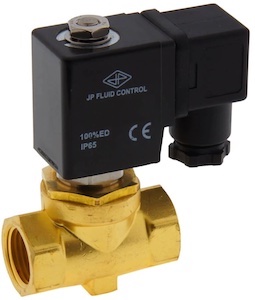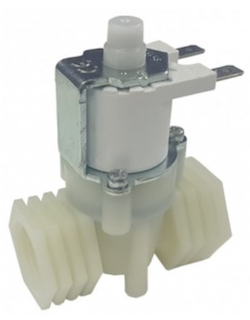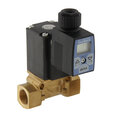Normally Open vs Normally Closed Solenoid Valve

Figure 1: A normally closed 2-way solenoid valve
Understanding the key differences between normally open (NO) and normally closed (NC) solenoid valves is crucial for selecting the appropriate type for an application. NO solenoid valves allow fluid flow when de-energized, while NC solenoid valves block flow in the same state. This article overviews the design differences between normally open and normally closed solenoid valves, how they work, and when to use each type.
Table of contents
- Normally open solenoid valve
- Normally closed solenoid valve
- Fail open vs fail close
- Choosing the right solenoid valve for an application: NO or NC
- Bi-stable solenoid valves
- FAQs
View our online selection of solenoid valves!
Normally open solenoid valve
A normally open solenoid valve is open in its de-energized state. There are various designs, but a basic design has the armature positioned high up in the coil. So when the valve energizes, the armature is pulled down towards the center of the coil. A plunger or piston attached to the armature moves down, closing the valve. When the valve is again de-energized, a spring pushes the armature back up, opening the valve. Learn more about the design and working of solenoid valves in our solenoid valve overview article.
Applications
Normally open solenoid valves are used in applications where it is critical to maintain flow in the event of a power failure. Some common use cases are:
- Safety systems: In fire suppression systems, NO solenoid valves ensure that water or other extinguishing agents are available even if power is lost.
- Cooling systems: In industrial cooling systems, maintaining coolant flow is crucial to prevent overheating of machinery.
- Ventilation systems: In HVAC systems, NO valves can ensure continuous air flow in case of power outages.
Normally closed solenoid valve
A normally closed solenoid valve is closed in its de-energized state. As with normally open valves, there are a variety of designs. A simple design has the armature low in the coil. When the valve is energized, the armature moves up towards the current's center, pulling a plunger or piston. This opens the valve. When the current stops, a spring pushes the armature back down to close the valve.
Applications
Normally closed solenoid valves are used in applications where it is critical to stop flow in the event of a power failure. Some common use cases include:
- Fluid control systems: In automated fluid control systems, NC solenoid valves are used to start and stop the flow of liquids or gasses.
- Pneumatic systems: In pneumatic control systems, NC valves control the flow of compressed air to actuators and other components.
- Fuel systems: In fuel delivery systems, NC solenoid valves ensure that fuel flow is stopped when the system is not in operation.
Fail open vs fail close
In industrial applications, "fail open" and "fail close" describe the default state of a valve during a power failure or system malfunction. Fail open mechanisms correspond to normally open solenoid valves, which remain open when de-energized, ensuring continuous flow. Fail close mechanisms correspond to normally closed solenoid valves, which remain closed when de-energized, stopping flow to enhance safety. Industry standards often dictate the necessity for fail-safe operations tailored to specific safety protocols.
Choosing the right solenoid valve for an application: NO or NC
The choice between normally open and normally closed solenoid valves depends on various factors, like the operational requirements, safety considerations, and energy efficiency.
Operational requirements
- Default state: NO valve is suitable for applications where continuous flow is required, and the valve only needs to close occasionally. The NC valve remains closed when de-energized. Ideal for applications where the flow needs to be stopped by default and only allowed when necessary.
- Frequency of operation: NC valves are generally preferred for applications requiring frequent opening and closing, as they provide better control and reliability. NO valves are suitable for applications where the valve remains open most of the time and only closes occasionally.
Safety considerations
In the event of a power failure that de-energizes the solenoid valve, the system's safety depends on whether the valve remains open or closed. For hazardous media, a normally closed (NC) solenoid valve is typically employed to halt the flow and prevent potential damage to the system or environment. However, if a pressure-build up is the emergency concern, then a normally open solenoid valve should be used.
- NO: Ensures continuous flow during power failures. Critical for safety systems like fire suppression, where the availability of extinguishing agents must be guaranteed.
- NC: Ensures flow is stopped during power failures. Essential for hazardous applications like fuel delivery or chemical processing, where preventing leaks and spills is crucial.
Energy efficiency
If a valve is open significantly more than it is closed, then to save on energy cost a normally open valve would be beneficial. Conversely, if the valve is usually closed, a normally closed valve would save on energy cost.
-
Power consumption:
- NO: Consumes power only when the valve needs to be closed. More energy-efficient in applications where the valve is predominantly open.
- NC: Consumes power continuously when the valve needs to be open. Less energy-efficient in applications where the valve is predominantly open.
- Duty cycle: For applications requiring the valve to remain in a specific state for extended periods, the energy consumption of the solenoid coil must be considered. NO valves are more efficient for continuous open states, while NC valves are more efficient for continuous closed states.
Bi-stable solenoid valves
Sometimes an application requires a solenoid valve to be open for a long time and then closed for a long time. In such cases, a bi-stable solenoid valve is the best solution due to its energy efficiency. Bi-stable valves use a power supply for a very short period of time to change the armature's position, thus opening or closing the valve. When there is no power, the armature does not change its position. Latching solenoid valves are found in a number of different industries. A door lock, however, is a specific example of an application that would likely use a bi-stable valve rather than normally open or normally closed. A small amount of power can open or close the lock, which then remains in its position until power is again supplied to the solenoid valve. Read our article on latching solenoid valves to learn more.

Figure 2: A latching solenoid valve
FAQs
Are solenoid valves normally open or normally closed?
Solenoid valves can be normally open or normally closed. Bi-stable solenoid valves are also available.
What does normally open mean on a solenoid valve?
A normally open solenoid valve is open in the valve's de-energized state. When current flows through the solenoid, a normally open solenoid valve closes.









